
|
|

August 25, 2006
Roxborough Tower Farm, Philadelphia, PA (part I)
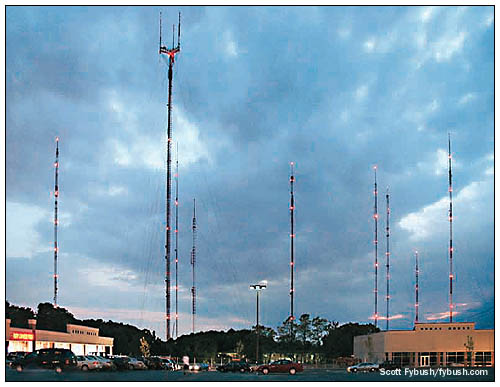 Tower
Site Calendar 2007 will be rolling off the presses in just a
few days - and it's already available for pre-orders at a special
discount price. (Read on for details - and you can get in even
earlier by subscribing to fybush.com at the $60 level, which
will put you first on the list to get a free copy!)
Tower
Site Calendar 2007 will be rolling off the presses in just a
few days - and it's already available for pre-orders at a special
discount price. (Read on for details - and you can get in even
earlier by subscribing to fybush.com at the $60 level, which
will put you first on the list to get a free copy!)
For the next few weeks here on Site of the Week, we'll be featuring some of the sites that you'll see on our sixth annual calendar - and this week, since we're on the road gathering new sites to show you in future weeks (and in future calendars), we're revisiting - and updating - some earlier features.
This is "Miss November" for 2007 - the famed Roxborough tower farm in Philadelphia, seen at dusk during last September's NAB Radio Show there.
Back in October 2003, we featured Roxborough in a two-part installment of Tower Site of the Week, and here's a reprise of Part I:
There are a few tower sites in America that deserve a place in the Tower Site Hall of Fame. There's Mount Wilson above Los Angeles, South Mountain above Phoenix, Cedar Hill south of Dallas, the Empire State Building in New York - and our featured attraction this week and next, Philadelphia's Roxborough tower farm.
Located in a suburban neighborhood verging on rural, yet within Philadelphia city limits, just five miles or so northeast of City Hall on the northern banks of the Schuylkill River, Roxborough offers a little of everything that makes a great tower site great: plenty of history, impressively tall steel (eight towers over 1000'), and even a three-tower AM directional amidst all the FM, TV and DTV.
In all, there are thirteen significant towers amidst the cluster (and just a couple of miles out to the west along Ridge Pike, the very significant AM sites of WZZD 990/WFIL 560 and KYW 1060 add to the picture); by my count, Roxborough is home to 10 full-power analog TV signals, 11 DTVs and 16 full-power FM facilities - not to mention a dynamite view from I-76, the Schuylkill Expressway that runs along the southern banks of the river.
Let's start our look at Roxborough with the view looking south from Ridge Pike, the main east-west highway that runs past the towers, as captured on a cloudy day in the summer of 1995 and again, in bright sun, eight years later (this should really be an animated GIF, I suppose, if anyone wants to turn these two images into one):
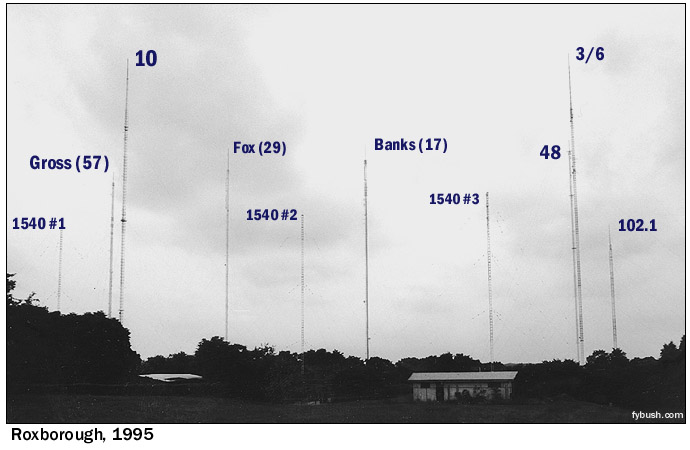
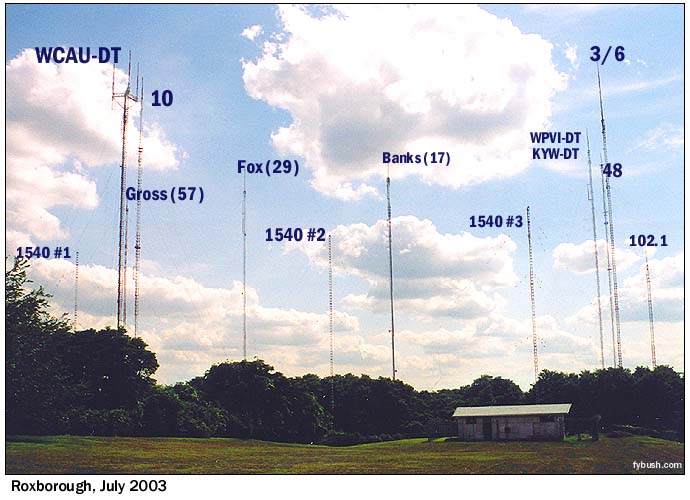
 Former
WFLN tower: The appropriate place to begin our look at Roxborough,
though, is at the one site not shown in the images above.
Former
WFLN tower: The appropriate place to begin our look at Roxborough,
though, is at the one site not shown in the images above.
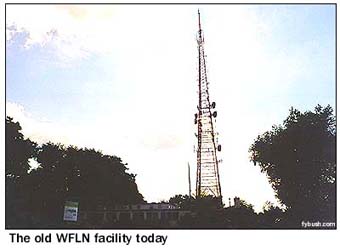 Out
on the western edge of Roxborough, this self-supporting tower
went up in 1949 as the home of WFLN (95.7), Philadelphia's first
stand-alone FM station.
Out
on the western edge of Roxborough, this self-supporting tower
went up in 1949 as the home of WFLN (95.7), Philadelphia's first
stand-alone FM station.
For nearly 50 years, WFLN called this building and tower at 8200 Ridge Pike home, and for most of that time, it was Philadelphia's voice of classical music. (It added an AM facility in the late fifties, a little station squeezed onto the dial at 900 kHz; that AM is now WURD and will be featured on a later Site of the Week.)
But not long after our 1995 visit, WFLN was sold to Greater Media. The classical music came to an end in 1997, replaced by modern AC as WXXM ("Max"), which later gave way to rhythmic oldies WEJM and then to AC WMWX ("Mix"), none of which ever achieved the ratings success of WFLN.
By the time WMWX came around, 95.7 had abandoned the 8200 Ridge transmitter location. The tower ended up in the hands of American Tower, while the building became the studio of public TV WYBE (Channel 35). Today, the tower is a temporary home for Fox's WTXF-DT (Channel 42) and many non-broadcast tenants.
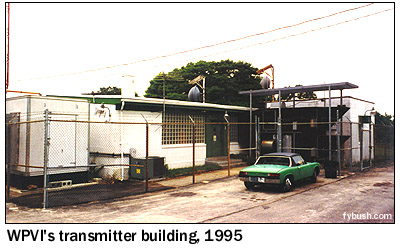 WPVI/KYW
Complex: By the time WFLN was building its tower up by Ridge
Pike and Port Royal Avenue, the first tower had already gone
up in what would become the heart of the Roxborough cluster.
WPVI/KYW
Complex: By the time WFLN was building its tower up by Ridge
Pike and Port Royal Avenue, the first tower had already gone
up in what would become the heart of the Roxborough cluster.
At the dead end of Wigard Avenue, south of Ridge, Walter Annenberg's WFIL-TV (Channel 6) signed on in 1947 from a 600-foot four-sided guyed tower that rose on a huge piece of land Annenberg bought for the purpose. WFIL-TV was the second station in town; Philco's WPTZ (Channel 3) had already been on the air for years from Wyndmoor, a few miles to the north, while the Philadelphia Bulletin's WCAU-TV would sign on a few months later on channel 10 from the PSFS Building in Center City Philadelphia.
WFIL-FM (102.1) became the second FM in Roxborough when it signed on from the WFIL tower not long after its TV sister.
By the late 1950s, all of Philadelphia's TV stations were looking for increased tower height to serve a market that was growing to include the Lehigh Valley, northern Delaware and all of south Jersey - and that's when Annenberg got a new tenant at Roxborough. In 1957, channel 3, by then owned by NBC and operating as WRCV-TV, abandoned the old Wyndmoor site and, in partnership with WFIL-TV, put up an 1116' tower on Annenberg's land. Channel 6 moved from its original tower to share the new tower; WFIL-FM stayed put on the original tower, where it lives to this very day as WIOQ.
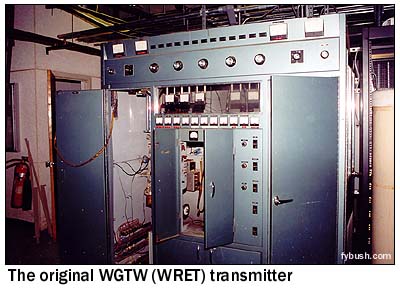
|
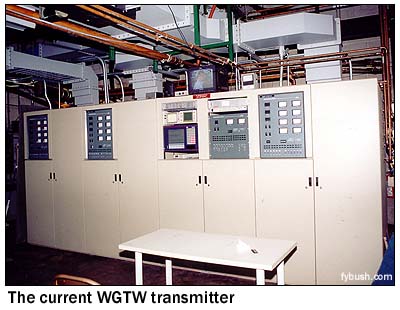 |
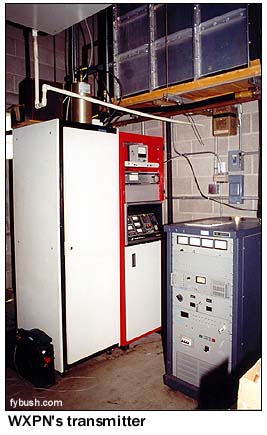
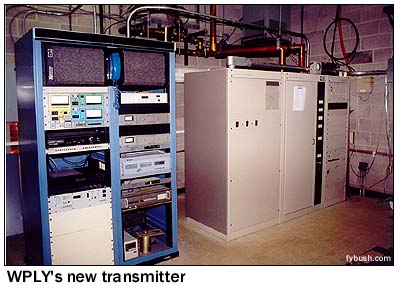 In 1965, another
tower went up on Annenberg's land, as he leased space behind
the channel 6 transmitter building to the new Kaiser Broadcasting
UHF outlet, WKBS-TV (Channel 48), which built its own 1108' stick
and transmitter building.
In 1965, another
tower went up on Annenberg's land, as he leased space behind
the channel 6 transmitter building to the new Kaiser Broadcasting
UHF outlet, WKBS-TV (Channel 48), which built its own 1108' stick
and transmitter building.
WKBS lasted almost 20 years, signing off in 1983 amidst great uncertainty about the renewal of the lease for its tower site.
The channel 48 license was reopened for competitive applicants, and one of them - Cornerstone Television of Pittsburgh - bought the tower and transmission equipment from WKBS in hopes of getting the license.
In the end, channel 48 went instead to Dorothy Brunson, and the old transmitter and antenna were shipped to Altoona, where Cornerstone put them back on the air on channel 47 as...yup, WKBS. Brunson bought a used Townsend transmitter from Charlotte, N.C., where it had been operating on channel 36, where it had been purchased by one R.E. Turner for the station he named after himself, WRET.
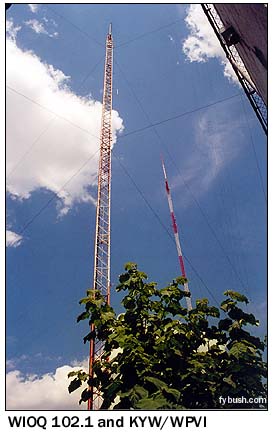 (You
might know Mr. Turner better by his nickname, "Ted,"
and you might be interested to know that he sold the Charlotte
station to Westinghouse to finance the startup of the Cable News
Network.) Brunson finally got channel 48 back on the air in 1993
as WGTW, a relatively low-budget independent operation.
(You
might know Mr. Turner better by his nickname, "Ted,"
and you might be interested to know that he sold the Charlotte
station to Westinghouse to finance the startup of the Cable News
Network.) Brunson finally got channel 48 back on the air in 1993
as WGTW, a relatively low-budget independent operation.
Around that same time, the University of Pennsylvania's WXPN made a big move, jumping from 88.9 to 88.5 and increasing power substantially so as to qualify for Corporation for Public Broadcasting funding. To alleviate the potential for interference to channel 6 (by then known as WPVI), WXPN moved in right next door at the channel 48 facility. (Its move also allowed for the creation of three new stations, WXVU at Villanova University and WYBF at Cabrini College sharing time on 89.1 and WBZC at Burlington Community College in New Jersey on 88.9.)
And just last year, WXPN and WGTW got some company in a corner of their building, as WPLY (100.3 Media) moved into the Roxborough farm from outlying Newtown Square. That move required an unusual ERI nine-panel cogwheel directional antenna on the channel 48 tower, but it finally gave WPLY a signal that's truly competitive with the other big Philly FMs at Roxborough.
Also last year, yet another tower went up behind the venerable channel 6 building. In order to accommodate their new digital TV signals, channel 6 (now owned and operated by ABC) and channel 3 (now CBS owned-and-operated KYW-TV) again joined forces to build a new tower and transmitter building.
At 1276 feet, the new KYW-DT (Channel 26)/WPVI-DT (Channel 64) tower is the tallest of all the Roxborough towers. You can see the new DTV building at the left of the picture below, behind the long transmission line that leads from the old channel 6 building to the 1957 channel 3/6 tower. The new DTV tower is the leftmost of the three behind channel 6's building; channel 48 is in the center and the original 1947 tower (now used solely by 102.1) is at right.
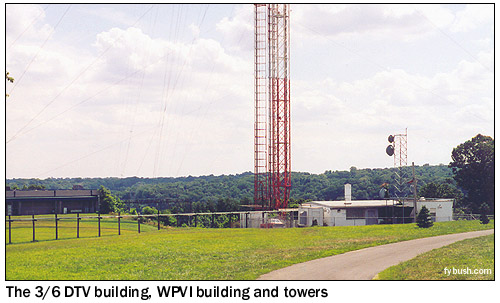 You
can get a sense of how high Roxborough is in relation to the
rest of Philadelphia (this piece of land is about 250 feet above
sea level, while Center City is pretty much at sea level) by
noting how short the STL tower next to the channel 6 building
is.
You
can get a sense of how high Roxborough is in relation to the
rest of Philadelphia (this piece of land is about 250 feet above
sea level, while Center City is pretty much at sea level) by
noting how short the STL tower next to the channel 6 building
is.
One more tower, not shown here, sits next to the channel 3 transmitter building, which is out of frame to the left of this photo. It went up here when channel 3 moved to Roxborough in 1957, and housed the old channel 3 antenna that was moved from Wyndmoor. That antenna was used as an auxiliary channel 3 facility for decades before finally being replaced by a weather radar system ("Live Mega Doppler 3") for KYW-TV.
When I first visited Roxborough in 1995, there was an engineer working at the KYW-TV transmitter building that day, and as a fellow Westinghouse employee back then, I was welcomed in for the nickel tour. Below you can see the old and (then) new Harris transmitters; that's a young Garrett Wollman, on one of his first long tower-hunting trips, to the right of the "new" transmitter.
(One of the biggest regrets of my tower-hunting career stems from that day: offered a ride up the 3/6 tower's elevator, I declined, since Garrett and I were in a hurry to meet up with a radio convention touring several stations in New Jersey. What was I thinking?)
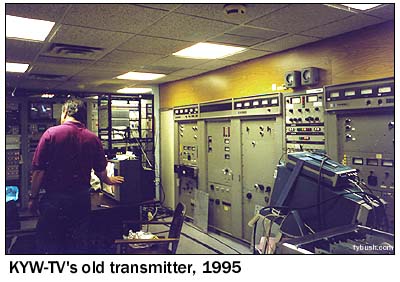
|
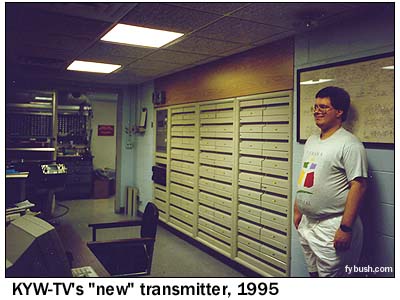
|
WNWR 1540: In the mid-sixties, AM radio came to Roxborough as well. WJMJ 1540 had been a 1000 watt religious daytimer with a transmitter site in New Jersey, but it needed a new transmitter site when it won a construction permit to go to 50,000 watts with three towers. So Rust Craft Broadcasting ended up with a piece of land on the south side of Ridge, west of Domino Lane, and 1540 was reborn as country WRCP. In later years, 1540 would become WSNI, then WPGR and finally multiethnic WNWR. It had a CP for night operation in the early nineties, and even operated after dark for a time, but with only 100 watts it just wasn't worth the trouble, so WNWR remains a daytimer. That's its transmitter building in the foreground of the two wide shots of Roxborough at the top of the page.
In part two of our 2003 look at Roxborough, we go over to Domino Lane and take a look at the WCAU-TV site and the towers known as "Banks," "Fox" and "Gross" - check it out!
 (And
a 2003 issue of Radio World contained an article
of mine with more historical information and nifty photos of
Roxborough - check
it out here!)
(And
a 2003 issue of Radio World contained an article
of mine with more historical information and nifty photos of
Roxborough - check
it out here!)
But before you dip into the archives to visit those articles, we hope you'll take a minute to place a pre-publication order for Tower Site Calendar 2007!
In addition to the Roxborough picture seen at the top of the page, there are more than a dozen additional photos of broadcast sites large and small around the U.S., along with fascinating dates in radio history and more.
And if you order before September 1, you can get the 2007 calendar at the same price we charged last year. Just visit the Fybush.com store to place your order, and you'll have your calendar in hand just after Labor Day.
- Previous Site of the Week: WJOT, Wabash, IN
- Next Week: KGO, San Francisco
- Site of the Week INDEX!
- How can you help support Site of the Week? Click here!
- Submit your suggestions for a future Site of the Week!
